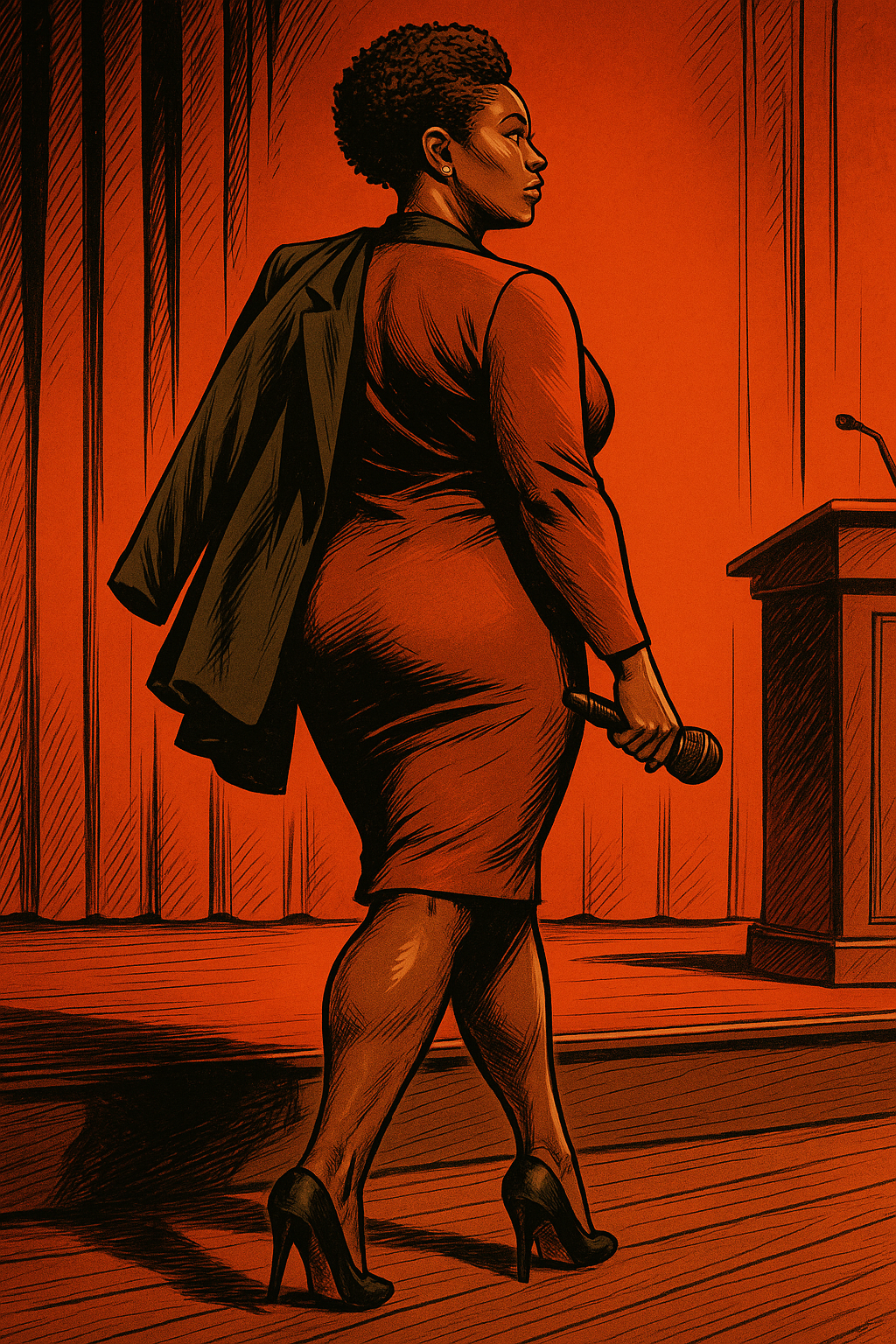No More “Little Ol’ Me”: The Infamous Woman’s Guide to Killing Imposter Syndrome
“The Stage Is Hers”: Black woman center stage under a spotlight, standing tall and powerful, symbolizing women stepping into their light.
“As women, we tend to downplay ourselves. We tend to dim our light and we’re kind of conditioned socially to be humble. And I grew up in the age of hip hop…and none of my favorite artists are humble.” – Issa Rae
Issa Rae stood on that stage at the 2019 Women in Film event and decided she wasn’t going to shrink.
She wasn’t going to second-guess herself.
She wasn’t going to question if she belonged.
She wasn’t going to perform humility just to make others comfortable.
She wasn’t going to do what so many of us do—doubt herself, even after she had already earned her place.
Instead, she owned her success without apology and left the stage with the now-iconic words:
🔥 “Entrepreneur till I die; I deserve this. Bye.”
And whew—what a way to exit.
Because how many of us can actually say we’ve owned our success that boldly?
How many of us—after grinding, after proving ourselves, after showing up and showing out—can say:
🔥 I deserve this. Period.
If we’re being honest?
Most of us don’t.
Instead, we shrink.
We downplay our success.
We perform humility because we think it’s what we’re supposed to do.
And for many of us? That humility is just a mask for imposter syndrome.
The Imposter Syndrome Trap: The Next Installment
This post continues our Counterfeit series—part of the Forged, Counterfeit, and Fake collection—where we’re exploring what happens when perfection, performance, and pressure convince us to hide behind false versions of ourselves.
Last week’s post was Sis, No Shade But…Aren’t You Tired of Being A High-Functioning Fraud—where we unpacked how high-functioning fraud looks and feels when you’ve already “made it.” To read it, click here.
This week, we’re diving into the Imposter Syndrome Trap—what it costs us to keep proving our worth and how to finally break free from performing humility.
“The Weight of Doubt” — A Visual Story of Imposter Syndrome: A comic book–style illustration showing a golden balance scale. On one side, stacks of books, diplomas, and a trophy represent success. On the other side, a smaller, anxious Black woman with chocolate-brown skin and natural hair sits in a pan labeled “DOUBT.” The warm orange lighting and deep shadows highlight the emotional contrast, symbolizing how imposter syndrome makes doubt feel heavier than achievement.
What Is Imposter Syndrome?
Before we go any further, let’s define exactly what we’re talking about.
Imposter syndrome is the persistent belief that you’re not as competent, talented, or deserving as people think you are—despite actual evidence of your success.
It’s the inner voice that whispers:
🔹 You’re not really qualified.
🔹 You just got lucky.
🔹 Any moment now, they’ll figure out you don’t belong.
And the worst part? No amount of achievement silences it.
Imposter syndrome doesn’t care how many degrees you have.
It doesn’t care how many promotions you’ve earned.
It doesn’t care how many times you’ve won, succeeded, or proven yourself.
It just keeps telling you that you don’t deserve to be where you are.
And here’s what makes it even trickier: Imposter syndrome isn’t just about self-doubt.
It’s also a defense mechanism.
“The Fear of Falling”: A woman climbs a glowing ladder toward the words “You Earned This,” while shadowy hands labeled expectations and failure reach from below.
Why We Call Ourselves Imposters—Even When We’ve Earned It
Because if we admit we’re not a fraud—if we admit we actually earned our success—then the stakes get higher.
If we fail?
🔥 We can’t blame it on luck—we have to own it.
If we succeed?
🔥 We can’t write it off as a fluke—we have to adjust our standard to something higher.
And for some of us? That’s terrifying.
Because staying in “I don’t really belong here” mode lets us protect ourselves from both expectations and disappointment.
“The Loop”: Several versions of a woman run in a loop labeled “Prove Yourself Again,” symbolizing burnout from imposter syndrome.
The Cost of Staying in the Imposter Syndrome Trap
But here’s the thing: That protection is also a prison.
🔹 It keeps us from fully stepping into our power.
🔹 It forces us to prove ourselves over and over—when we’ve already done it.
🔹 It stops us from celebrating what we’ve earned—because we keep waiting for someone to “catch” us.
And that? That’s a setup.
Because if you don’t believe in your own success, you will:
🔥 Let other people take credit for your work.
🔥 Accept less than you deserve—because you think you’re “lucky” to have it.
🔥 Stay stuck in cycles of overworking, over-proving, and over-explaining yourself.
And for what?
At some point, you have to call it what it is:
It’s not luck. It’s not an accident. It’s not a mistake.
🔥 You did that.
🔥 You earned that.
🔥 You belong here.
“You Built This”: A woman stands before a glowing city made of bricks labeled faith, vision, and discipline, symbolizing success built through effort.
How to Own Your Success—Without the Apology
If you are going to step out of the Imposter Syndrome Trap, you need to do three things:
1️⃣ Say It With Your Chest: You Deserve This.
Issa Rae didn’t stand on that stage and say, “Wow, I’m so honored. I never imagined this happening to little ol’ me.”
No.
She said:
🔥 Entrepreneur till I die. I deserve this. Bye.
Now, say it for yourself.
Not “I got lucky.”
Not “I was in the right place at the right time.”
Not “They must have seen potential in me.”
No. You earned this. Own it.
2️⃣ Stop Preparing for Someone to “Find You Out.”
You are not an imposter.
You are qualified, experienced, and equipped.
The only fraud is the lie you’ve been telling yourself that you don’t belong.
3️⃣ Adjust Your Standard—Not Your Excuses.
🔥 You’ve won before.
🔥 You’ve succeeded before.
🔥 You’ve been in rooms you never imagined—and you held your own.
Stop calling it a fluke just because success still feels new.
Instead of saying, “This probably won’t happen again,” say:
🔥 “This is my new normal.”
Because it is.
You didn’t stumble into this moment. You built it.
And if you built it once, you can build it again.
The question isn’t whether you belong here.
The question is: What are you going to build next?
SIDE BAR: 💭 Sis, Let’s Be Clear…
Just because I’m talking about imposter syndrome doesn’t mean I’m saying you’re insecure or ungrateful.
We were taught to question ourselves. We were trained to shrink so others could feel comfortable.
And when you’ve had to fight for every inch of space you stand in, it’s no wonder you second-guess whether you belong there.
But listen—
Humility isn’t pretending you don’t deserve the win.
Confidence isn’t arrogance.
And owning your power doesn’t mean you’ve forgotten where you came from.
It means you finally believe you belong at the table you built.
So no, you’re not faking it.
You’re finally facing it.
“Stepping Out of the Trap”: A woman steps from a glowing broken glass box, symbolizing freedom from self-doubt and limitation.
The Final Question: Will You Step Out of the Trap?
Because shrinking doesn’t serve you.
Playing small won’t protect you.
And humility doesn’t mean erasing yourself.
So the question is: Are you ready to stop explaining yourself and start expanding yourself?
Are you ready to stop waiting for permission and start owning your power?
Because the answer is simple:
🔥 You’ve already earned this. Now act like it.
You’re successful till you die. You deserve this. Bye.
Dr. Sagashus inviting you into the IMverse through the Wanted Newsletter or coaching.
The Final Question: Will You Step Out of the Trap?
Because the only thing heavier than doubt—
Is carrying it while you’ve already earned your place.
✨ Use the Covet Journal to map your forge, name your fire, and recognize your hammer.
📖 Read A Pot to P*ss In — proof that survival isn’t the endgame. Discernment is.
🎟️ Join us at a Without Apology Tour stop in Madison or beyond — because your fire isn’t just a test. It’s a blueprint.
And Sis? If you’re ready to go deeper—beyond reading, beyond nodding along, beyond pretending you’ll figure it out alone—this is your moment.
👉 Learn more. If you’re interested in coaching, explore our coaching page here. Because doing it alone ain’t where it’s at. You deserve the ease, comfort, and satisfaction that comes with support, sisterhood, and systems that will get you there.
Call to Action…
Listen. If this word spoke to you, don’t just leave it here. Carry it with you. Wanted is where we keep the good tea flowing — a reminder every week that you are desired, you are dangerous, and you belong. It’s where we keep you updated on current events across the IMverse, including the Without Apology Tour. And it’s where we introduce new stories, people, and dirty words.
👉🏾 Join Wanted today.
ABOUT THE BLOGGER
Dr. Sagashus Levingston is an author, entrepreneur and PhD holder. She has two fur babies, Maya and Gracie, six children (three boys and three girls), and they all (including her partner) live in Madison, WI. She loves all things business, is committed to reminding moms of their power, and is dedicated to playing her part in closing the wealth gap for people of color and women. She believes that mothering is a practice, like yoga, and she fights daily to manage her chocolate intake. The struggle is real, y’all…and sometimes it’s beautiful.
Follow her on Instagram: @infamous.mothers








